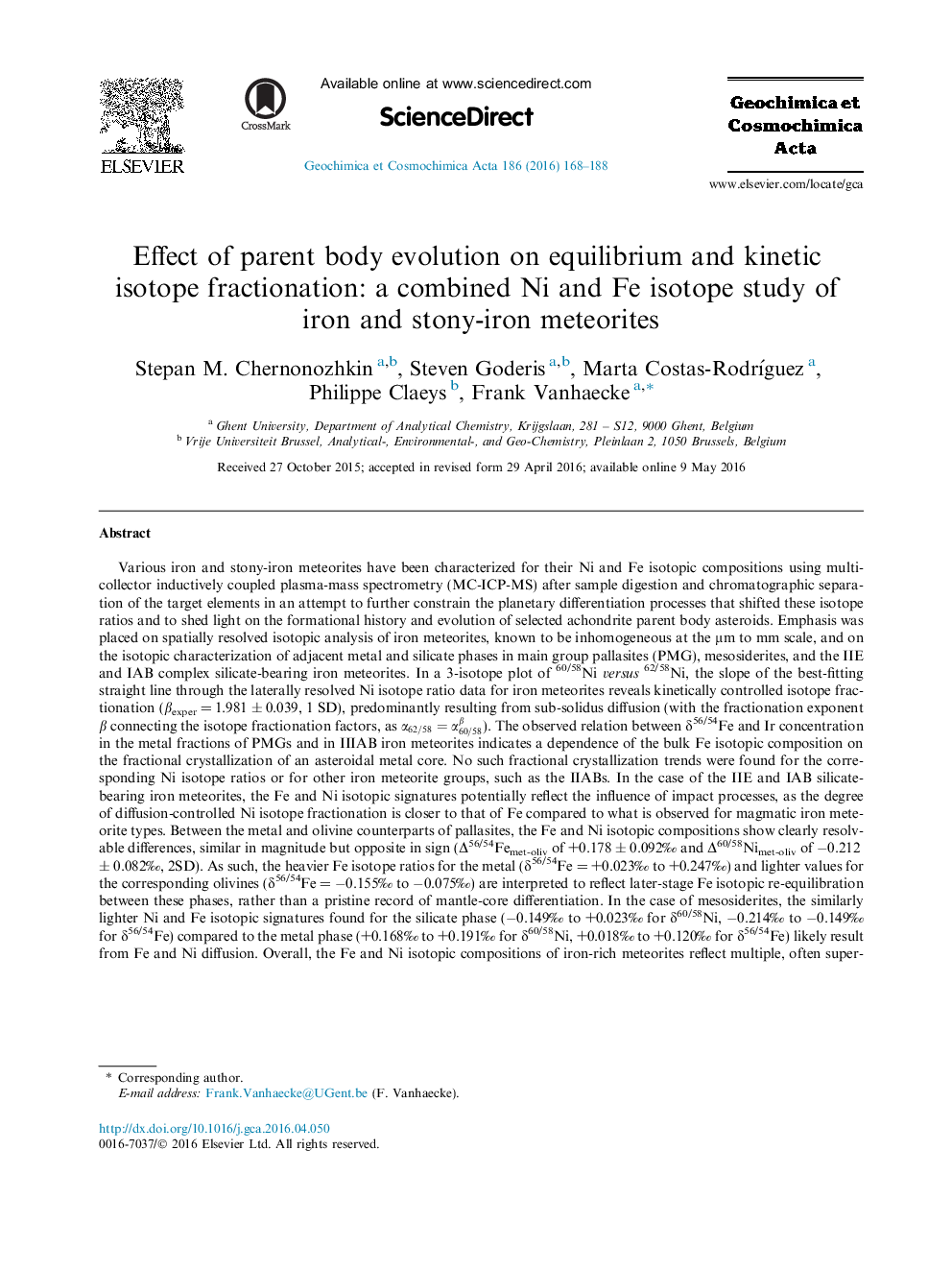| کد مقاله | کد نشریه | سال انتشار | مقاله انگلیسی | نسخه تمام متن |
|---|---|---|---|---|
| 6437290 | 1637971 | 2016 | 21 صفحه PDF | دانلود رایگان |

Various iron and stony-iron meteorites have been characterized for their Ni and Fe isotopic compositions using multi-collector inductively coupled plasma-mass spectrometry (MC-ICP-MS) after sample digestion and chromatographic separation of the target elements in an attempt to further constrain the planetary differentiation processes that shifted these isotope ratios and to shed light on the formational history and evolution of selected achondrite parent body asteroids. Emphasis was placed on spatially resolved isotopic analysis of iron meteorites, known to be inhomogeneous at the μm to mm scale, and on the isotopic characterization of adjacent metal and silicate phases in main group pallasites (PMG), mesosiderites, and the IIE and IAB complex silicate-bearing iron meteorites. In a 3-isotope plot of 60/58Ni versus 62/58Ni, the slope of the best-fitting straight line through the laterally resolved Ni isotope ratio data for iron meteorites reveals kinetically controlled isotope fractionation (βexper = 1.981 ± 0.039, 1 SD), predominantly resulting from sub-solidus diffusion (with the fractionation exponent β connecting the isotope fractionation factors, as α62/58=α60/58β). The observed relation between δ56/54Fe and Ir concentration in the metal fractions of PMGs and in IIIAB iron meteorites indicates a dependence of the bulk Fe isotopic composition on the fractional crystallization of an asteroidal metal core. No such fractional crystallization trends were found for the corresponding Ni isotope ratios or for other iron meteorite groups, such as the IIABs. In the case of the IIE and IAB silicate-bearing iron meteorites, the Fe and Ni isotopic signatures potentially reflect the influence of impact processes, as the degree of diffusion-controlled Ni isotope fractionation is closer to that of Fe compared to what is observed for magmatic iron meteorite types. Between the metal and olivine counterparts of pallasites, the Fe and Ni isotopic compositions show clearly resolvable differences, similar in magnitude but opposite in sign (Î56/54Femet-oliv of +0.178 ± 0.092â° and Î60/58Nimet-oliv of â0.212 ± 0.082â°, 2SD). As such, the heavier Fe isotope ratios for the metal (δ56/54Fe = +0.023â° to +0.247â°) and lighter values for the corresponding olivines (δ56/54Fe = â0.155â° to â0.075â°) are interpreted to reflect later-stage Fe isotopic re-equilibration between these phases, rather than a pristine record of mantle-core differentiation. In the case of mesosiderites, the similarly lighter Ni and Fe isotopic signatures found for the silicate phase (â0.149â° to +0.023â° for δ60/58Ni, â0.214â° to â0.149â° for δ56/54Fe) compared to the metal phase (+0.168â° to +0.191â° for δ60/58Ni, +0.018â° to +0.120â° for δ56/54Fe) likely result from Fe and Ni diffusion. Overall, the Fe and Ni isotopic compositions of iron-rich meteorites reflect multiple, often superimposed, processes of equilibrium or kinetic nature, illustrating convoluted parent body histories and late-stage interaction between early-formed planetesimal reservoirs.
Journal: Geochimica et Cosmochimica Acta - Volume 186, 1 August 2016, Pages 168-188